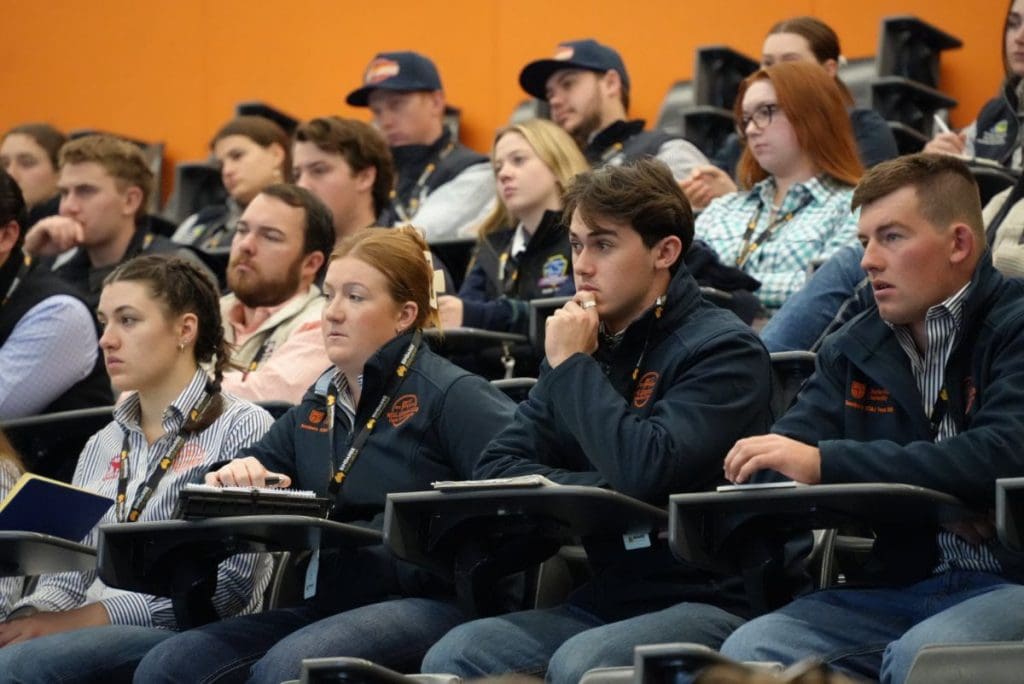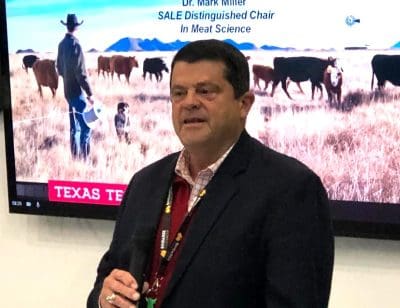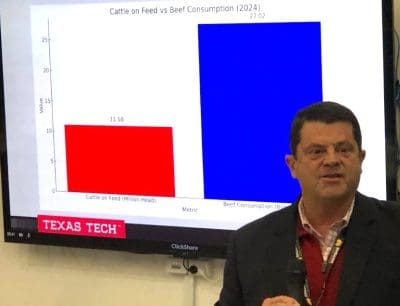
Undergraduates at the ICMJ conference this week
AUSTRALIA and the United States need each other to meet the demand of their consumers for high quality beef, lamb and goat meat – that was the message from Texas Tech University’s Professor Mark Miller at a gathering in New South Wales today.
At the 2025 Intercollegiate Meat Judging Competition conference being held in Wagga Wagga, Professor Miller outlined ‘Why is the USA such a great market for Aussie beef, lamb and goat?’
Prof Miller said consumers chose to eat high quality beef because of ‘tenderness, juiciness and flavor’ and were prepared to pay more for it than chicken and pork because it changed the way they feel.
“This is why Australia and the US make great partners and we are a great place for your beef.”
No market concerns seen in US beef imports into Australia
Prof. Miller voiced no concerns for Australia if it changed its regulations around US beef imports, assuming biosecurity concerns were satisfied. Australia currently allows imports of US-grown beef but not product from Canadian and Mexican sourced cattle processed in America.

Prof Mark Miller addresses this morning’s ICMJ conference
“When you get down to it, the need for US beef here is probably minimal because you can’t consume what you produce here and you produce awesome beef here.
“So even if US beef did come into Australia, I don’t think it is going to come in price-competitive and have an impact on the Australian beef industry,” he said.
“So why not let it come in?
“I don’t think it’s going to be a threat and that’s what I said in my talk at the very beginning: we’re not competitors.”
Prof Miller said Australia and the US really don’t compete at all because they don’t produce the same beef.
“We produce beef that is made totally different to Australian beef so it won’t erode markets here.”
He said America needs Australian beef – especially ground beef – because the US cannot produce enough to meet demand.
“Our beef consumption is going up, up and up, we can eat all we can produce, and we actually eat more than we can produce so we need high quality safe beef and Australia provides it.
Prof Miller told Beef Central that he did not believe President Trump’s tariffs would influence American beef or lamb production.
“I really think that the tariffs are simply a tool to be able to talk, because we haven’t seen large implementations of extremely high price tariffs like we did in 2017.
“Every country that the tariffs have been talked about to have never really been implemented either way and I think the nations are talking a lot about how to make them fair for every sector of production … let’s figure out how to make it fair,” he said.
“Nobody wins unless it’s free trade, but it has to be fair for each other.”

Prof Mark Miller
He characterised reports of US aiming to impose tariffs that match those of countries at certain levels as “nothing but ‘say hey we’ve got to talk and get together and make this fair for both sides.’”
Prof Miller said the issues of trade and US tariffs have been blown out of proportion in the media. He said suggestions that Australia and the US were not “partners and not family members” is not true.
He said Australia and the US were two of the most friendly and important trading partners in the meat sector.
“We need you, we need to have a great relationship and family, and you’ve seen that because our companies have come together.
“JBS is heavily involved in US meat production, consumption, sales and marketing, Teys and Cargill are related,” he said.
Prof Miller said students that he brought to Australia 20 years ago are working in the US industry and conversing with Australian students they met here.
“And they are actually trading, buying and selling as they move up through companies and working together to bring us together.”
Good beef makes you feel good
He said US research showed that a good beef eating experience “lit up a part of your brain that changes everything about the way that you feel.”
“It causes the compounds to release in your brain that make you feel warm, satisfied and very happy for a long period of time.”
 Prof Miller outlined how this had led to “beef addiction,” with US consumers in February this year, Americans consumed 27 percent more beef than they did in the same period in 2024.
Prof Miller outlined how this had led to “beef addiction,” with US consumers in February this year, Americans consumed 27 percent more beef than they did in the same period in 2024.
“In March, we consumed 19pc more than we did in 2024, in April 18pc (more) and in May we consumed 19pc (more).
“So on average, we are on target to consume 20pc more beef in the US in 2025 and the price has gone up 20pc,” he said.
“So if you do any economics, it doesn’t make sense, price goes up demand always goes down right, supply and demand?
“But in the US that’s not happening and the reason why is because of what I just described to you; it’s creating an addiction because people are subliminally going to buy beef because they want to feel good.”
Bad beef = negative reinforcer
But he said a bad beef eating experience is a negative reinforcer and activated a part of the brain as if “the worst thing had happened to you.”
Prof Miller said producing and grading high quality beef is the most important thing that the ICMJ students and producers can do to secure future sales in America.
The demand for high quality beef extended to ground beef, which is 75pc of all US beef meals are ground products, and is another reason why Australia’s quality beef is needed in the US, he said.
Australia and the US were not competitors, because the American product was different and did not compete in the same market segments.
“Because your high quality beef, you produce about 1 million head of those a year, with long grain feeding, and our total industry is based on that.”
He said hormonal growth promotants were used on almost every US fed beef animal.
“Less than one tenth of one percent of all US cattle that are fed do not get an HGP. Here it is just the opposite of that, so we’re not competing in the same space,” Prof Miller said.
“You’re competing in a different segment than what we are, we’re actually allies, friends – you produce things that we don’t produce, we produce things you don’t produce, so we’re not competitors.
“That’s why we are seeing companies from your nation and ours buy each other, be partners together.”
Prof Miller said 30-40 years Australian beef was not high quality, it was beef and sold on price in large volumes to the US for ground beef and mince products. But with the introduction of the Meat Standards Australia grading system and collaboration with the US on consumer testing “that mapped out what the target needs to be for Australian beef production.”
“So that relationship right there and our relationship to be able to find out what the US consumer wants gives you as the Australian industry and community a target to hit the final consumer.”
Prof Miller said America’s cow beef population is the lowest it has been in history, but production is its highest, because technology – HGPs and beta agonists – is being used to produce heavier carcases quicker.
Nevertheless, the US had a major shortage of beef and Australia was needed to meet that supply shortfall, he said.
Prof Miller said the US sheep flock is lower than it was five years ago, but consumer demand for lamb is increasing.
He said Australia is the US’s largest importer of lamb because American consumers demand “the highest quality lamb on the planet”. A major study using Australian and American lamb showed that US and Chinese consumers demand tender, juicy and flavorsome lamb.
“We found out that American consumers love lamb, they just don’t know how to prepare it.”
Prof Miller said a large part of the US population also liked to eat goat meat, but the country did not have a large supply.
“We have 330 million consumers and I expect that we are going to grow and be in the top ten (of countries) in goat consumption probably in the next decade.”

HAVE YOUR SAY